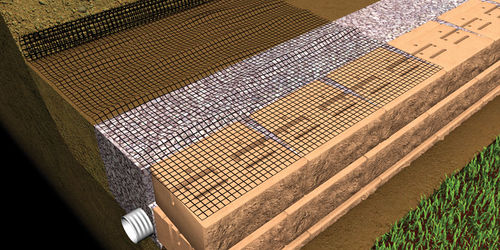VERSA-LOK walls are designed as traditional gravity walls. A wedge of potentially unstable soils behind the wall system is resisted by the weight of the wall system. For shorter, unreinforced walls, the VERSA-LOK units provide the stabilizing weight. For taller walls, where the loads exceed the stability of the units alone, a larger gravity mass system is created from geogrid-reinforced soil faced with VERSA-LOK units.
Unreinforced vs Reinforced Retaining Walls
Unreinforced Retaining Wall

Reinforced Retaining Wall

To ensure stability of a reinforced retaining wall, the wall engineer must design a geogrid-reinforced mass large enough to resist loads from outside the wall system (external stability) and with enough geogrid layers of sufficient strength to keep the reinforced soil mass together (internal stability and internal compound stability) and to keep top units stable and all the units properly connected to the reinforced soil mass (facial stability).
The project geotechnical engineer typically evaluates the subsurface conditions around the wall to determine if bearing failures, excessive foundation soil settlement, or global stability is a concern.
Loading on VERSA-LOK walls is dependent on soil conditions, surcharges, slopes, water conditions, and wall heights. Accurate knowledge of each of these properties is needed for an efficient design. Soil properties used in the standard design methodology (NCMA) include the internal friction angles (Φ) and soil unit weight (γ). Generally, for the structural wall design, the cohesion (c) of any fine grained soils is conservatively ignored to simplify the design.
Analysis Modes
Internal Stability
Pullout

Tensile Overstress

Internal Sliding

For internal stability, the wall designer can address potential overstress by using a higher strength geogrid or adding more geogrid layers (by reducing vertical space between geogrid layers). Potential pullout or internal sliding concerns can be addressed by lengthening the geogrid layers.
Facial Stability
Crest Toppling

Facing Connection

Internal Compound
Internal Compound

For facial stability, the wall design engineer can address connection concerns by adding geogrid layers (including shorter supplementary layers) or using a higher connection strength geogrid. Crest toppling can be addressed by adding geogrid layers closer to the top of the wall.
External Stability
Base Sliding

Overturning

For external stability, potential overturning or sliding can be both addressed by lengthening the geogrids to create a larger, more stable reinforced soil mass.
Goetechnical Concerns
Bearing Capacity and Excessive Settlment

Global / Slope Stability

Evaluation of geotechnical concerns are generally the responsibility of soils engineer. However, in some cases, those can be addressed by lengthening and strengthening the geogrid layers beyond what is required for the structural wall design.
Addressing Potential Failure Modes
For internal stability, the wall designer can address potential overstress by using a higher strength geogrid or adding more geogrid layers (by reducing vertical space between geogrid layers). Potential pullout or internal sliding concerns can be addressed by lengthening the geogrid layers.
Internal compound stability is the potential for compound failures starting directly behind the wall, passing through the reinforced soil mass and exiting out front face of the wall. The wall design engineer can address internal compound stability by using a higher strength geogrid type, adding geogrid layers, lengthening geogrid layers or improving the reinforced soil type.
For facial stability, the wall design engineer can address connection concerns by adding geogrid layers (including shorter supplementary layers) or using a higher connection strength geogrid. Crest toppling can be addressed by adding geogrid layers closer to the top of the wall.
For external stability, potential overturning or sliding can be both addressed by lengthening the geogrids to create a larger, more stable reinforced soil mass.
Evaluation of geotechnical concerns are generally the responsibility of soils engineer. However, in some cases, those can be addressed by lengthening and strengthening the geogrid layers beyond what is required for the structural wall design.

